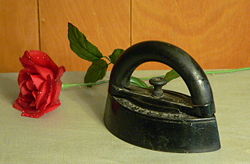Sadiron
The sadiron (sometimes spelt sad iron - two words) was the precursor to the modern electric steam iron typically used in today's households for pressing and ironing. The name is based on an archaic usage of the word sad which meant heavy, dense, or solid. Typical sadirons weigh from a few pounds up to 10 pounds.
Introduced in the early 18th century, the sadiron consisted of a forged block of iron with a flat bottom. The iron was heated, initially over an open cook fire in a hearth (when one had to be careful to keep the bottom clean lest soot and ashes be transferred to the clothing), and later over a wood cookstove. When the iron cooled, it needed to be re-heated. Typically, two sadirons were used in tandem. While one was being used, the other was heating. When the one being used cooled off, it was placed over the fire to be re-heated and the other, which in the interim had become heated, was used.
In the early 1870s, in one of those undercelebrated moments in technological history, Mrs. Mary Florence Potts of Ottumwa, Iowa, invented and patented an "improved sad-iron" which was designed not only to more evenly distribute the heat and stay hot longer, but had a detachable wooden handle. Prior to this, the sadiron featured an iron handle which was one piece with the unit itself. As it too got hot along with the unit, it had to be gripped with some type of cloth and users were constantly subject to getting burns from handling the implement.
The new, detachable wooden handle sadiron was exhibited at the Centennial Exposition in Philadelphia in 1876 and became an instant "must have" household implement.
The sadiron was in common use through the early decades of the 20th century but by mid-century had largely disappeared, having been replaced by the electric iron. Today, it's use as an everyday implement of household management is largely restricted to the Amish, the majority of whom continue to use the sadiron for at least some of their ironing chores. Other than that, it is mainly of interest to antique collectors.
Reading
- Glissman, A.H., The Evolution of the Sad-Iron (1970)
